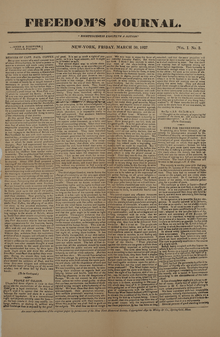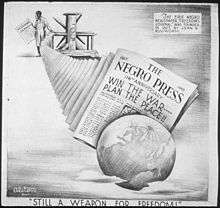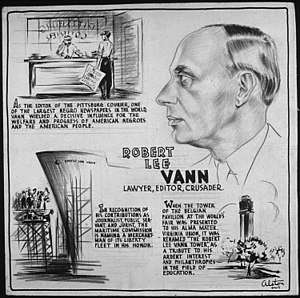African-American newspapers
African-American newspapers are newspapers in the United States serving African-American communities. Samuel Cornish and John Brown Russwurm started the first African-American periodical called Freedom's Journal in 1827. During the antebellum South, other African-American newspapers sprang forth, such as The North Star founded in 1847 by Frederick Douglass.

As African Americans moved to urban centers around the country, virtually every large city with a significant African-American population soon had newspapers directed towards African Americans. These newspapers gained audiences outside African-American circles. In the 21st century, papers (like newspapers of all sorts) have shut down, merged, or shrunk in response to the dominance of the Internet in terms of providing free news and information, and providing cheap advertising.[1][2]
History

Origins
Most of the early African-American publications, such as Freedom's Journal, were published in the North and then distributed, often covertly, to African Americans throughout the country.[3] By the 20th century, daily papers appeared in Norfolk, Chicago, Baltimore and Washington, D.C..[4]
19th century
Some notable black newspapers of the 19th century were Freedom's Journal (1827–29), Philip Alexander Bell's Colored American (1837–41), the North Star (1847–60), the National Era, The Frederick Douglass Paper (1851–63), the Douglass Monthly (1859–63), and the Christian Recorder (1861–1902)[5]
In the 1860s, the newspapers the Elevator and the Pacific Appeal emerged in California as a result of black participation in the Gold Rush. [6] In the late 19th century, the main reason that newspapers were created was to uplift the black community. Many black people sought to assimilate into larger society and Northern blacks felt that it was their duty to educate Southern blacks on the mores of Victorian society. The African-American newspaper titled "The American Freedman" was a New York-based paper that served as an outlet to inspire African Americans to use the Reconstruction period as a time for social and political advancement. This newspaper did so by publishing articles that reference African-American mobilization during the Reconstruction period that had not only local support, but had gained support from the global community as well. Many African-American newspapers struggled to keep their circulation going due to the low rate of literacy among African Americans. Many freed African Americans had low incomes and could not afford to purchase subscriptions but shared the publications with one another.[7]
The national Afro-American Press Association formed in 1890 in Indianapolis.[8][9]
20th century

African-American newspapers flourished in the major cities, with publishers playing a major role in politics and business affairs. Representative leaders included Robert Sengstacke Abbott (1870–1940), publisher of the Chicago Defender; John Mitchell, Jr. (1863–1929), editor of the Richmond Planet and president of the National Afro-American Press Association; Anthony Overton (1865–1946), publisher of the Chicago Bee, Garth C. Reeves, Sr. (1919-2019), Publisher Emeritus of the Miami Times and Robert Lee Vann (1879–1940), the publisher and editor of the Pittsburgh Courier.[10] In the 1940s the number of newspapers grew from 150 to 250.[11]
The national, Chicago-based Associated Negro Press (1919–1964) was a news agency "with correspondents and stringers in all major centers of black population."[12]
There were many specialized black publications, such as those of Marcus Garvey and John H. Johnson. These men broke a wall that let black people into society. The Roanoke Tribune was founded in 1939 by Fleming Alexander, and recently celebrated its 75th anniversary. The Minnesota Spokesman-Recorder is Minnesota's oldest black newspaper and the United States' oldest ongoing minority publication, second only to The Jewish World.
21st century
Many Black newspapers that began publishing in the 1960s, 1970s, and 1980s went out of business because they could not attract enough advertising. They were also victims of their own substantial efforts to eradicate racism and promote civil rights. As of 2002, about 200 Black newspapers remained. With the decline of print media and proliferation of internet access, more black news websites emerged, most notably Black Voice News, The Grio, The Root, and Black Voices.
See also
References
- Arvarh E. Strickland and Robert E. Weems, eds. The African American Experience: An Historiographical and Bibliographical Guide (Greenwood, 2001), pp 216-30.
- Simmons, Charles A. The African American press: a history of news coverage during national crises, with special reference to four black newspapers, 1827-1965. McFarland, 2006, p. 2.
- Jacqueline Bacon, "The history of Freedom's Journal: A study in empowerment and community." Journal of African American History 88.1 (2003): 1–20. in JSTOR
- Jacqueline Bacon, Freedom's journal: the first African-American newspaper (2007).
- Knowlton, Steven. "LibGuides: African American Studies: Newspapers: 19th century". Libguides.princeton.edu. Retrieved October 25, 2017.
- "Archived copy". Archived from the original on 2016-04-01. Retrieved 2016-07-27.CS1 maint: archived copy as title (link)
- Rhodes, Jane (1998). Mary Ann Shadd Carry: The Black Press and Protest in the Nineteenth Century. Bloomington, In: Indiana University Press. pp. 120–123. ISBN 0-253-21350-9.
- Nina Mjagkij, ed. (2001), Organizing Black America: an Encyclopedia of African American Associations, Garland, ISBN 9780815323099
- Gonzalez 2011.
- Patrick S. Washburn, The African American Newspaper: Voice of Freedom (2006).
- Mott, Frank Luther (1950). American Journalism: The history of newspapers in the United States 1690-1950. Macmillan. p. 794.
- "Associated Negro Press", Encyclopedia of Chicago, Chicago Historical Society, retrieved March 20, 2017
Further reading
- Bacon, Jacqueline. Freedom's journal: the first African-American newspaper (Lexington Books, 2007)
- Belles, A. Gilbert. "The Black Press in Illinois." Journal of the Illinois State Historical Society (1975): 344-352. online
- Bradshaw, Katherine A. "Eye on the Struggle: Ethel Payne, the First Lady of the Black Press." Journalism History 41.1 (2015): 53+
- Brown, Warren Henry (1946). Check list of Negro newspapers in the United States (1827-1946). Jefferson City, Mo.: Lincoln University School of Journalism. OCLC 36983520.
- Bullock, Penelope L. The Afro-American Periodical Press, 1838-1909 (LSU Press, 1981).
- Buni, Andrew (1974). Robert L. Vann of the Pittsburgh courier: politics and Black journalism. University of Pittsburgh Press. Archived from the original on 2013-10-29.
- Burma, John H. "An analysis of the present Negro Press." Social forces (1947): 172-180. in JSTOR
- Dann, Martin E. The Black Press, 1827-1890: The Quest for National Identity (1972).
- Davis, Ralph N. "The Negro Newspapers and the War." Sociology and Social Research 27 (1943): 378-380.
- Detweiler, Frederick German (1922). The Negro Press in the United States. University of Chicago Press.
- Dijk, Teun A. van (1995). "Selective Bibliography on Ethnic Minorities, Racism and the Mass Media". Electronic Journal of Communication. ISSN 1183-5656. (includes USA)
- Eldridge, Lawrence Allen. Chronicles of a Two-front War: Civil Rights and Vietnam in the African American Press (University of Missouri Press, 2012)
- Finkelman, Paul, ed. (2006). "Newspapers". Encyclopedia of African American History, 1619-1895. 2. Oxford University Press. ISBN 978-0-19-516777-1.
- Finkle, Lee. Forum for protest: The black press during World War II (Fairleigh Dickinson University Press, 1975)
- Gonzalez, Juan; Joseph Torres (2011). News for All the People: The Epic Story of Race and the American Media. Verso Books. ISBN 978-1-84467-942-3.
- Gershenhorn, Jerry. Louis Austin and the Carolina Times: A Life in the Long Black Freedom Struggle. Chapel Hill: University of North Carolina Press, 2018.
- Guskin, Emily, Paul Moore, and Amy Mitchell. "African American media: Evolving in the new era." in The State of the News Media 2011 (2011).
- Henritze, Barbara K. Bibliographic Checklist of African American Newspapers (Genealogical Publishing Com, 1995)
- Hogan, Lawrence D. A black national news service: the Associated Negro Press and Claude Barnett, 1919-1945 (Fairleigh Dickinson Univ Press, 1984)
- Jones, Allen W. "The Black Press in The" New South": Jesse C. Duke's Struggle for Justice and Equality." Journal of Negro History 64.3 (1979): 215-228. in JSTOR
- La Brie, Henry G. A survey of Black newspapers in America (Mercer House Press, 1973).
- Meier, August. "Booker T. Washington and the Negro Press: With Special Reference to the Colored American Magazine." Journal of Negro History (1953): 67-90. in JSTOR
- Morris, James McGrath. Eye on the Struggle: Ethel Payne, the First Lady of the Black Press (New York: Amistad, 2015). xii, 466 pp.
- Oak, Vishnu Vitthal. The Negro Newspaper (Greenwood, 1970)
- Odum-Hinmon, Maria E. "The Cautious Crusader: How the Atlanta Daily World Covered the Struggle for African American Rights from 1945 to 1985." (PhD Dissertation University of Maryland, 2005).
- Penn, Irvine Garland (1891). The Afro-American Press and Its Editors. Massachusetts: Willey and Co.
- Pride, Armistead Scott; Clint C. Wilson (1997). History of the Black Press. Howard University Press. ISBN 978-0-88258-192-7.
- Prides, Armistead S. A Register and History of Negro Newspapers in the United States: 1827-1950. (1950)
- Simmons, Charles A. The African American press: a history of news coverage during national crises, with special reference to four black newspapers, 1827-1965 (McFarland, 2006).
- Stevens, John D. "Conflict-cooperation content in 14 Black newspapers." Journalism Quarterly 47#3 (1970): 566–568.
- Strickland, Arvarh E., and Robert E. Weems, eds. The African American Experience: An Historiographical and Bibliographical Guide (Greenwood, 2001), pp. 216–30, with long bibliography
- Suggs, Henry Lewis, ed. The Black press in the south, 1865-1979 (Praeger, 1983).
- Suggs, Henry Lewis, ed. The Black Press in the Middle West, 1865-1985 (Greenwood Press, 1996). 416 pp.
- Wade-Gayles, Gloria. "Black Women Journalists in the South, 1880-1905: An Approach to the Study of Black Women's History." Callaloo 11/13 (1981): 138–152. in JSTOR
- Washburn, Patrick S. The African American Newspaper: Voice of Freedom (Northwestern University Press, 2006); covers 1827-1900; emphasis on Pittsburgh Courier and the Chicago Defender
- Washburn, Patrick Scott. A question of sedition: The federal government's investigation of the black press during World War II (Oxford University Press, 1986).
- Wolseley, Roland Edgar. The black press, USA (Wiley-Blackwell, 1990).
Primary sources
- Dunnigan, Alice. Alone Atop the Hill: The Autobiography of Alice Dunnigan, Pioneer of the National Black Press (University of Georgia Press, 2015)